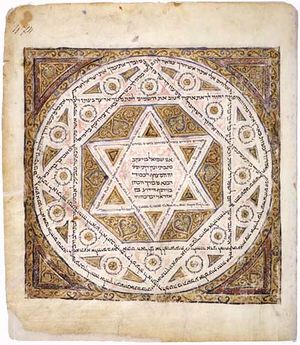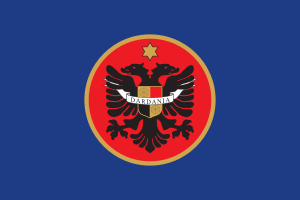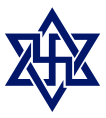نجمة سداسية
| نجمة سداسية منتظمة | |
|---|---|
 نجمة سداسية منتظم | |
| النوع | شكل مضلع منتظم |
| الأضلاع والرؤوس | {{{p6/2-جانب}}} |
| رمز شلفلي | {{{شلافلي-p6/2}}} |
| مخططات كوكستر-دنكن | |
| مجموعة التماثل | Dihedral (D6) |
| الزاوية الداخلية (الدرجات) | {{{بزاوية p6/2}}}° |
| الخصائص | star, compound, cyclic, متساوي الأضلاع، متوازي الأضلع، متجانس الأضلاع |
| المضلعات النجمية |
|---|
|
|

في الهندسة الرياضية، النجمة السداسية Hexagram، هي مضلع نجمي له ستة رؤوس، ويتشكل من اجتماع مثلثين متساويين الأضلاع with the Schläfli symbol {6/2}, 2{3}, or {{3}}. Since there are no true regular continuous hexagrams, the term is instead used to refer to a compound figure of two equilateral triangles. The intersection is a regular hexagon.
The hexagram is part of an infinite series of shapes which are compounds of two n-dimensional simplices. In three dimensions, the analogous compound is the stellated octahedron, and in four dimensions the compound of two 5-cells is obtained.
يعرف هذا الشكل بشكل واسع على أنه رمز للديانة اليهودية باسم نجمة داوود. The appearance of the symbol in Christian churches long before its appearance in our synagogues should warn the overzealous interpreters. "}} It was first used as a mystic symbol by Muslims in the medieval period, known as the Seal of Solomon, depicted as either a hexagram or pentagram, and which was later adopted by Jewish Kabbalists.[1][2]
Group theory
In mathematics, the root system for the simple Lie group G2 is in the form of a hexagram, with six long roots and six short roots.

Construction by compass and a straight edge
A six-pointed star, like a regular hexagon, can be created using a compass and a straight edge:
- Make a circle of any size with the compass.
- Without changing the radius of the compass, set its pivot on the circle's circumference, and find one of the two points where a new circle would intersect the first circle.
- With the pivot on the last point found, similarly find a third point on the circumference, and repeat until six such points have been marked.
- With a straight edge, join alternate points on the circumference to form two overlapping equilateral triangles.
Construction by linear algebra
A regular hexagram can be constructed by orthographically projecting any cube onto a plane through three vertices that are all adjacent to the same vertex. The twelve midpoints to edges of the cube form a hexagram. For example, consider the projection of the unit cube with vertices at the eight possible binary vectors in three dimensions onto the plane . The midpoints are , and all points resulting from these by applying a permutation to their entries. These 12 points project to a hexagram: six vertices around the outer hexagon and six on the inner.
الأصول والشكل
The oldest known depiction of a six-pointed star (dating back to the 3rd millennium BC.) was excavated in the Ashtarak burial mound in “Nerkin Naver” (in Historic Armenia).
It is possible that as a simple geometric shape, like for example the triangle, circle, or square, the hexagram has been created by various peoples with no connection to one another.
The hexagram is a mandala symbol called satkona yantra or sadkona yantra found on ancient South Indian Hindu temples. It symbolizes the nara-narayana, or perfect meditative state of balance achieved between Man and God, and if maintained, results in "moksha," or "nirvana" (release from the bounds of the earthly world and its material trappings).[بحاجة لمصدر]
Some researchers have theorized that the hexagram represents the astrological chart at the time of David's birth or anointment as king. The hexagram is also known as the "King's Star" in astrological circles.
In antique papyri, pentagrams, together with stars and other signs, are frequently found on amulets bearing the Jewish names of God, and used to guard against fever and other diseases. Curiously the hexagram is not found among these signs. In the Greek Magical Papyri[بحاجة لمصدر] (Wessely, l.c. pp. 31, 112) at Paris and London there are 22 signs side by side, and a circle with twelve signs, but neither a pentagram nor a hexagram.
الاستخدام الديني
الديانات الهندية
Six-pointed stars have also been found in cosmological diagrams in Hinduism, Buddhism, and Jainism. The reasons behind this symbol's common appearance in Indic religions and the West are unknown. One possibility is that they have a common origin. The other possibility is that artists and religious people from several cultures independently created the hexagram shape, which is a relatively simple geometric design.
Within Indic lore, the shape is generally understood to consist of two triangles—one pointed up and the other down—locked in harmonious embrace. The two components are called "Om" and the "Hrim" in Sanskrit, and symbolize man's position between earth and sky. The downward triangle symbolizes Shakti, the sacred embodiment of femininity, and the upward triangle symbolizes Shiva, or Agni Tattva, representing the focused aspects of masculinity. The mystical union of the two triangles represents Creation, occurring through the divine union of male and female. The two locked triangles are also known as 'Shanmukha'—the six-faced, representing the six faces of Shiva & Shakti's progeny Kartikeya. This symbol is also a part of several yantras and has deep significance in Hindu ritual worship and history.
In Buddhism, some old versions of the Bardo Thodol, also known as The "Tibetan Book of the Dead", contain a hexagram with a swastika inside. It was made up by the publishers for this particular publication. In Tibetan, it is called the "origin of phenomenon" (chos-kyi 'byung-gnas). It is especially connected with Vajrayogini, and forms the center part of her mandala. In reality, it is in three dimensions, not two, although it may be portrayed either way.
The Shatkona is a symbol used in Hindu yantra that represents the union of both the male and feminine form. More specifically it is supposed to represent Purusha (the supreme being), and Prakriti (mother nature, or causal matter). Often this is represented as Shiva - Shakti.[3]
Anahata or heart chakra is the fourth primary chakra, according to Hindu Yogic, Shakta and Buddhist Tantric traditions. In Sanskrit, anahata means "unhurt, unstruck, and unbeaten". Anahata Nad refers to the Vedic concept of unstruck sound (the sound of the celestial realm). Anahata is associated with balance, calmness, and serenity.
اليهود

The Magen David is a generally recognized symbol of Judaism and Jewish identity and is also known colloquially as the Jewish Star or "Star of David." Its usage as a sign of Jewish identity began in the Middle Ages, though its religious usage began earlier, with the current earliest archeological evidence being a stone bearing the shield from the arch of a 3–4th century synagogue in the Galilee.[4]
المسيحية
The first and the most important Armenian Cathedral of Etchmiadzin (303 AD, built by the founder of Christianity in Armenia) is decorated with many types of ornamented hexagrams and so is the tomb of an Armenian prince of the Hasan-Jalalyan dynasty of Khachen (1214 AD) in the Gandzasar Church of Artsakh.
The hexagram may be found in some Churches and stained-glass windows. In Christianity, it is sometimes called the star of creation. A very early example, noted by Nikolaus Pevsner, can be found in Winchester Cathedral, England in one of the canopies of the choir stalls, circa 1308.[5]
الإسلام


The symbol is known in Arabic as Khātem Sulaymān (Seal of Solomon; خاتم سليمان) or Najmat Dāwūd (Star of David; نجمة داوود). The "Seal of Solomon" may also be represented by a five-pointed star or pentagram.
In the Qur'an, it is written that David and King Solomon (Arabic, Suliman or Sulayman) were prophets and kings, and are figures revered by Muslims. The Medieval pre-Ottoman Hanafi Anatolian beyliks of the Karamanids and Jandarids used the star on their flag.[6] The symbol also used on Hayreddin Barbarossa flag. Today the six-pointed star can be found in mosques and on other Arabic and Islamic artifacts.
Coin minted in the Emirate of Sicily during the reign of Al-Mustansir Billah (11th century CE)
1204 coin minted in Aleppo by Az-Zahir Ghazi
Hexagram at Humayun's Tomb, Delhi, India (late 16th century)
Hexagram on obverse of Moroccan 4 Falus coin (1873)
Hexagram on the Minaret of Arasta Mosque, Prizren, Kosovo
Hexagram on the flag of Hayreddin Barbarossa
Hexagram on the flag of Karamanid beylik
The Gates from the tomb of Mahmud of Ghazni, taken to the Somnath temple
النبالة
الصوفية
الواقعية
السحر والتنجيم
الماسونية
"The interlacing triangles or deltas symbolize the union of the two principles or forces, the active and passive, male and female, pervading the universe ... The two triangles, one white and the other black, interlacing, typify the mingling of apparent opposites in nature, darkness and light, error and truth, ignorance and wisdom, evil and good, throughout human life." – Albert G. Mackey: Encyclopedia of Freemasonry
The hexagram is featured within and on the outside of many Masonic temples as a decoration. It may have beenقالب:Whom found within the structures of King Solomon's temple, from which Freemasons are inspired in their philosophies and studies. Like many other symbols in Freemasonry, the deciphering of the hexagram is non-dogmatic and left to the interpretation of the individual.
استخدامات أخرى

Flags
- The flag of Australia had a six pointed star to represent the six federal states from 1901 to 1908.
- The Ulster Banner flag of Northern Ireland, used from 1953 to 1972. The six pointed star, representing the six counties that make up Northern Ireland. The star of the Ulster Banner is not the compound of two equilateral triangles. The intersection is not a regular hexagon.
- A flag used by rebels during the Whiskey Insurrection in South-Western Pennsylvania, 1794.
- A hexagram appears on the Dardania Flag, proposed for Kosovo by the Democratic League of Kosovo.
- The flag of Nigeria depicted a green hexagram surrounding a crown from with the white word "Nigeria" under it on a red disc from 1914 to 1960.
- The flag of Israel has a blue hexagram in the middle.
Other symbolic uses
- A six-point interlocking triangles has been used for thousands of years as an indication a sword was made, and "proved", in the Damascus area of the Middle East. Still today, it is a required "proved" mark on all official UK and United States military swords though the blades themselves no longer come from the Middle East.
- In southern Germany the hexagram can be found as part of tavern anchors. It is symbol for the tapping of beer and sign of the brewer's guild. In German this is called "Bierstern" (beer star) or "Brauerstern" (brewer's star).
- A six-point star is used as an identifying mark of the Folk Nation alliance of US street gangs.
- The Indian sage and seer Sri Aurobindo used it—e.g. on the cover of his books—as a symbol of the aspiration of humanity calling to the Divine to descend into life (the triangle with the point at the top), and the descent of the Divine into the earth's atmosphere and all individuals in response to that calling (the triangle with the point at the bottom). (This was explained by the Mother, his spiritual partner in Her 14-volume Agenda and elsewhere by Sri Aurobindo in his writings.)[بحاجة لمصدر]
Man-made and natural occurrences
- The main runways and taxiways of Heathrow Airport were arranged roughly in the shape of a hexagram.[7]
- A hexagram in a circle is incorporated prominently in the supports of Worthing railway station's platform 2 canopy (UK).
- An extremely large, free-standing wood hexagram stands in the central park of the Municipality of El Tejar, Guatemala. Additionally, every year at Christmastime the residents of El Tejar erect a giant fake Christmas tree in front of their municipal building, with a hexagram sitting at its peak.
Unicode
- In Unicode, the "Star of David" symbol ✡ is encoded in U+2721.
نجوم سداسية أخرى
| unicursal hexagram | Two uniform star-polyhedra have hexagram vertex figures | One star polyhedra has hexagram faces | ||
|---|---|---|---|---|
| D2 symmetry | D3 symmetry Vertex-transitive |
D3 symmetry Edge-transitive | ||

|
 Ditrigonal dodecadodecahedron |
 Great ditrigonal icosidodecahedron |
 Great triambic icosahedron | |
The figure {6/3} can be shown as a compound of three digons.
Other hexagrams can be constructed as a continuous path.
| مركبات منتظمة | D2 symmetry unicursal |
D3 symmetry isogonal |
D3 symmetry isotoxal | |||||
|---|---|---|---|---|---|---|---|---|
 {6/2}=2{3} |
 {6/3}=3{2} |

|

|

|

|

|

| |
انظر أيضا
المصادر
- Grünbaum, B. and G. C. Shephard; Tilings and Patterns, New York: W. H. Freeman & Co., (1987), ISBN 0-7167-1193-1.
- Grünbaum, B.; Polyhedra with Hollow Faces, Proc of NATO-ASI Conference on Polytopes ... etc. (Toronto 1993), ed T. Bisztriczky et al., Kluwer Academic (1994) pp. 43–70.
- Graham, Dr. O.J. The Six-Pointed Star: Its Origin and Usage 4th ed. Toronto: The Free Press 777, 2001. ISBN 0-9689383-0-2
- Wessely, l.c. pp. 31, 112
الهوامش
- ^ Scholem 1949, p. 246.
- ^ Leonora Leet, "The Hexagram and Hebraic Sacred Science" in :The Secret Doctrine of the Kabbalah, 1999, pp. 212-217.
- ^ sivasakti.com: Introduction to Yantra
- ^ "King Solomon's Seal", MFA, King Solomon-s Seal
- ^ Buildings of England: Hampshire and the North (now second edition) ISBN 978 0 300 12084 4, p.604.
- ^ The Muslim Empires of the Ottomans, Safavids, and Mughals, By Stephen F. Dale, 2009
- ^ bbc.co.uk and see File:Aerial photograph of Heathrow Airport, 1955.jpg
وصلات خارجية
- Short description is different from Wikidata
- Articles with unsourced statements from July 2010
- Articles with unsourced statements from February 2007
- Articles containing explicitly cited عربية-language text
- Articles with hatnote templates targeting a nonexistent page
- Pages using multiple image with auto scaled images
- Articles with unsourced statements from September 2017
- تاريخ الفن
- عمارة الكنائس
- Iconography
- Memes
- Ornaments
- مضلعات
- Rotational symmetry
- رموز
- تناظر
- Synagogue architecture
- عمارة المعابد
- Visual motifs
- هندسة ابتدائية




















